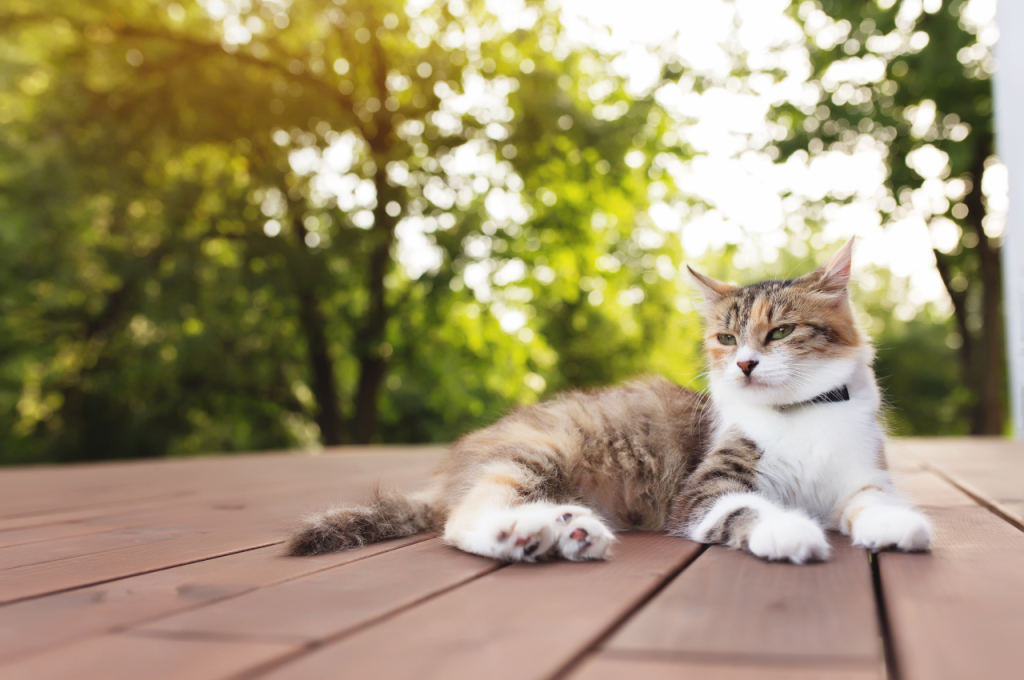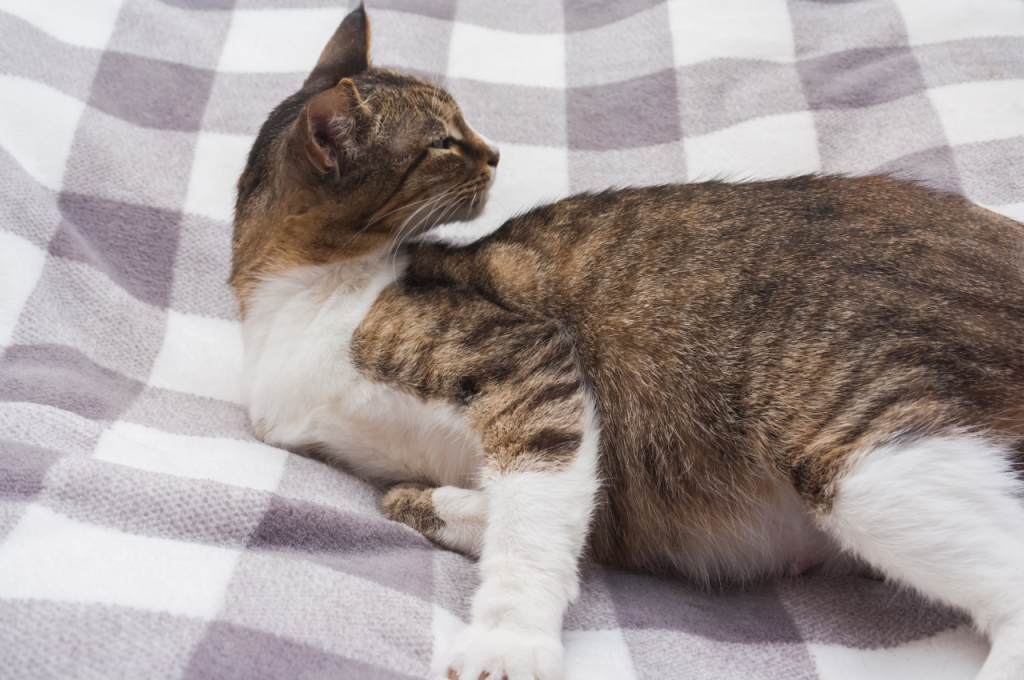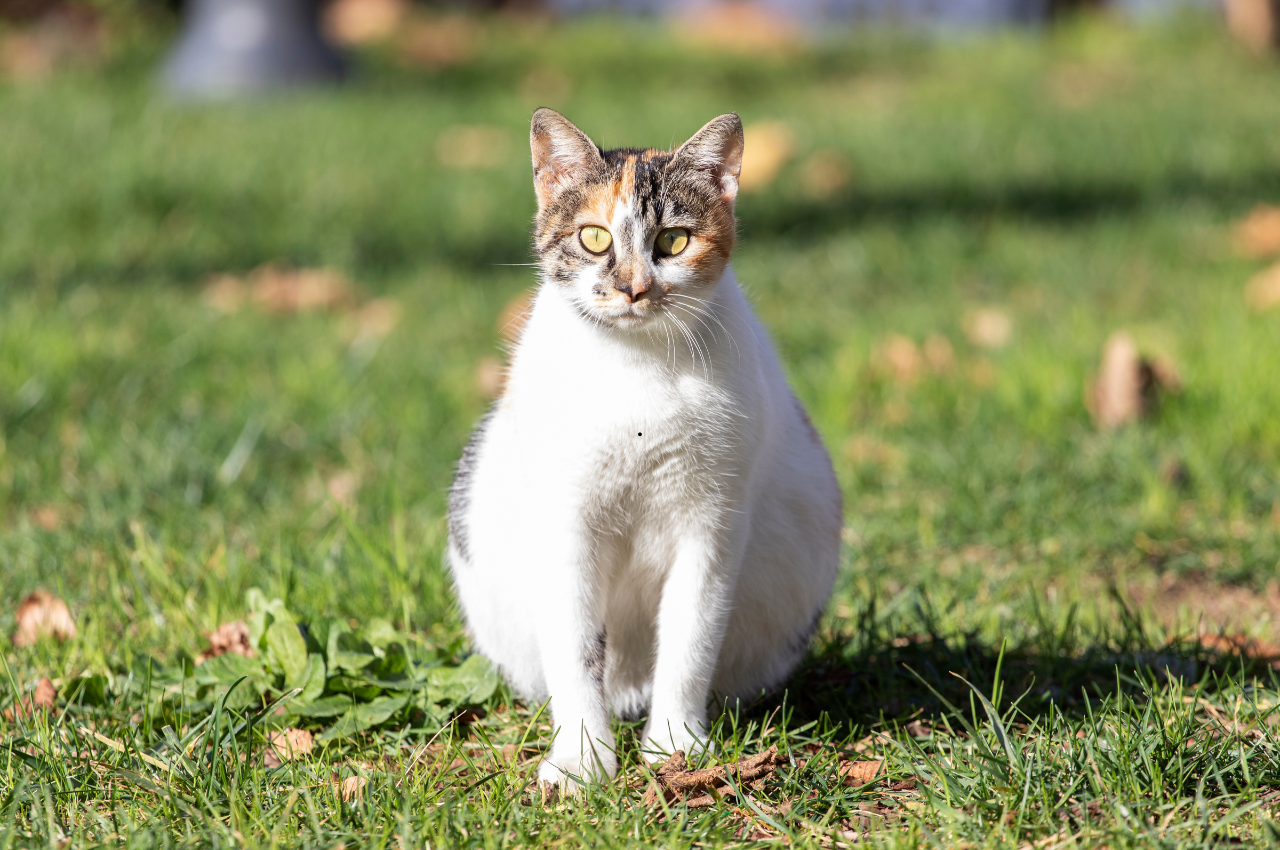A pregnant cat typically looks rounder and heavier, with a swollen abdomen and enlarged nipples. This is often referred to as “showing.”
During pregnancy, a cat’s belly will gradually become more distended as the kittens develop. Additionally, pregnant cats may exhibit behavioral changes, such as increased affection or nesting behaviors. It’s essential to provide proper care and nutrition to a pregnant cat to ensure the health of both the mother and her kittens.
Monitoring her weight gain, providing a comfortable and safe environment, and regular veterinary check-ups are crucial during this time. Understanding the physical and behavioral changes in a pregnant cat is important for providing the best care and support throughout her pregnancy.
Early Signs of Cat Pregnancy
The early signs of cat pregnancy can be subtle yet crucial to recognize for cat owners. Understanding these early indications can help provide proper care and support for the pregnant feline.

Physical Changes
Cats exhibit several physical changes in the early stages of pregnancy, including:
- Swollen Nipples: The cat’s nipples may become pinker and more prominent.
- Increased Appetite: Expect your cat to show a greater interest in food.
- Weight Gain: A pregnant cat may start gaining weight, especially around the abdomen.
Behavioral Shifts
During the early stages of pregnancy, cats may display the following behavioral changes:
- Nesting Behavior: Your cat might start seeking out quiet, cozy spots to nest.
- Affectionate: Some cats become more affectionate and seek extra attention.
- Restlessness: Restlessness or pacing may be observed in pregnant cats.
The Telltale Belly: Spotting The Bump
A pregnant cat’s belly undergoes various changes throughout the gestation period. Understanding the growth timeline can help you identify the different stages of pregnancy your cat is experiencing.
Here is a breakdown of the growth timeline:
| Weeks | Visual Cues |
| 1-3 | No visible changes in the belly |
| 4-5 | Subtle swelling in the lower abdomen |
| 6-7 | The noticeable bulge in the abdomen |
| 8-9 | The belly becomes more rounded and firm |
| 10-11 | The belly is noticeably larger and sagging |
| 12-14 | Maximum belly size, kittens can be felt through the skin |
Spotting the bump on a pregnant cat is not only about the size of the belly but also the visual cues that can help you determine if your cat is expecting.
- Enlarged Nipples: As the pregnancy progresses, the cat’s nipples will become larger and may change color. They will also feel firmer to the touch.
- Mammary Gland Development: Along with the enlarged nipples, the mammary glands will also start to develop and become more pronounced.
- Weight Gain: Pregnant cats usually gain weight during pregnancy. If your cat’s weight is increasing despite a normal appetite, it could be a sign of pregnancy.
- Behavioral Changes: Pregnant cats may exhibit nesting behaviors, become more affectionate, or show signs of restlessness.
By observing these visual cues, you can have a better idea of whether your cat is pregnant or not.
Changes in Appetite
During pregnancy, a cat’s appetite may undergo noticeable changes. It’s essential to understand these changes to provide the best care for your pregnant feline friend. Let’s explore the different aspects of a pregnant cat’s appetite, including increased hunger and dietary preferences.
Increased Hunger
Pregnant cats often experience increased hunger as their bodies work hard to support the growing kittens. This heightened appetite is a natural response to the increased energy and nutrients required during pregnancy. It’s important to provide additional food to accommodate this heightened hunger. However, it’s crucial to ensure that the food is nutritionally balanced to support the health of both the mother and her developing kittens.
Dietary Preferences
Pregnant cats may exhibit specific dietary preferences during different stages of pregnancy. Some may develop a preference for certain flavors or textures of food. It’s important to be observant of these preferences and be willing to adjust their diet accordingly. Providing a variety of high-quality, palatable foods can help ensure that the mother cat is getting the nutrition she needs, even if her preferences change throughout the pregnancy.
Nesting Behaviors
During pregnancy, cats may exhibit nesting behaviors, such as searching for a comfortable and safe place to give birth. Physically, a pregnant cat may have a swollen abdomen and enlarged nipples.

Preparing for Kittens
Nesting behaviors in pregnant cats are essential signs of impending labor. These behaviors indicate that the cat is preparing for the arrival of her kittens. She may exhibit these behaviors as early as a few days before giving birth.
Finding The Perfect Spot
Pregnant cats often search for a secluded and safe spot to give birth. They prefer quiet, warm, and comfortable areas. This ensures the safety and security of the newborn kittens. Nesting Behaviors are crucial indicators of a pregnant cat’s impending labor. She exhibits these behaviors to prepare for the arrival of her kittens, often starting a few days before giving birth. Cats search for warm, quiet, and safe spots to deliver their kittens, ensuring a secure environment for the newborns.
Mammary Gland Development
During pregnancy, a cat’s mammary glands undergo development, becoming enlarged and more prominent. This is one of the physical changes that can be observed to determine if a cat is pregnant. The mammary glands prepare for nursing and can be seen as swollen and pinkish in appearance.
Physical Inspection
When it comes to mammary gland development in a pregnant cat, one of the key indicators is the physical changes that occur in this area. By visually inspecting the cat, you can observe certain signs that indicate mammary gland development. During the early stages of pregnancy, the mammary glands might appear slightly swollen and enlarged. As the pregnancy progresses, you may notice further changes such as the development of individual mammary glands becoming more pronounced. The nipples may also become larger and pinker in color.
Timing of Changes
Understanding the timing of changes in a pregnant cat’s mammary gland development can provide valuable insights into the progression of the pregnancy. It is important to note that these changes can vary from one cat to another, so it’s essential to observe the individual cat’s specific timeline. Typically, mammary gland development starts occurring around two to three weeks into the pregnancy. This is when the cat’s hormone levels begin to change, triggering the growth and development of the mammary glands. As the pregnancy advances, the mammary glands continue to develop and prepare for lactation. It’s important to note that mammary gland development is not a definitive indicator of pregnancy on its own. To confirm pregnancy, it is recommended to consult a veterinarian who can perform further tests such as ultrasound or palpation.
Summary
In summary, mammary gland development in a pregnant cat can be observed through physical inspection. The swelling, enlargement, and changes in color of the mammary glands and nipples are key indicators of pregnancy. Understanding the timing of these changes can provide insights into the progression of the pregnancy. However, it is crucial to consult a veterinarian for confirmation of pregnancy through additional tests.
Behavioral Clues and Affection Levels
During pregnancy, a cat may show behavioral clues like increased affection levels, seeking more attention, and nesting behaviors. Physically, a pregnant cat may have a rounded belly, enlarged nipples, and weight gain.
During pregnancy, cats undergo physical and behavioral changes that are often visible. It is crucial to understand these changes to provide proper care and attention to your feline friend. In this article, we will focus on the behavioral clues and affection levels of pregnant cats, with a particular emphasis on seeking attention and mood swings.
Seeking Attention
Pregnant cats tend to seek more attention and affection from their owners than usual. They may follow their owners around, meow more often, and even climb into their laps more frequently. This behavior is common as pregnant cats require more attention and care than non-pregnant cats.
Mood Swings
Pregnancy hormones can cause mood swings in cats, just like in humans. You may notice your cat becoming more irritable or easily agitated. On the other hand, she may become more affectionate and seek more attention. As a pet owner, it is essential to be patient and understanding during this time. Here are some other behavioral clues you may observe in a pregnant cat:
- Decreased appetite or changes in eating habits
- Increased nesting behavior, such as burrowing into blankets or towels
- Restlessness or pacing
- More frequent grooming
- Increased vocalization
In conclusion, understanding the behavioral clues and affection levels of pregnant cats is crucial for providing proper care and attention. It is important to be patient and understanding during this time, as your cat may experience mood swings and behavioral changes. By providing the necessary care and attention, you can ensure a healthy and happy pregnancy for your feline friend.
Vet Visits and Ultrasounds
When it comes to ensuring the health and well-being of a pregnant cat, vet visits and ultrasounds play a crucial role. These visits not only confirm the pregnancy but also help in monitoring the health of the expecting mother and her developing kittens.
Confirming Pregnancy
Confirming the pregnancy of a cat involves a visit to the veterinarian. The vet will conduct a thorough examination, which may include palpation of the abdomen to feel for developing kittens or an ultrasound to visualize the growing fetuses. This step is essential in determining the cat’s pregnancy status and estimating the stage of gestation.
Monitoring Health
Monitoring the health of a pregnant cat is essential to ensure a smooth pregnancy and successful delivery. Regular vet check-ups help in assessing the overall well-being of the mother cat and identifying any potential health issues that may arise during the pregnancy. These visits also allow the vet to provide nutritional guidance and address any concerns related to the cat’s physical condition.
Preparing for Birth
A pregnant cat usually has a rounder belly, and swollen nipples, and may gain weight. Preparing for birth involves providing a comfortable nesting area and monitoring her health closely as the due date approaches.

Setting up a Birthing Area
Ensure a quiet and warm space for your pregnant cat to give birth. Use a large, shallow box lined with clean towels or newspapers. Place the box in a secluded area to provide a sense of security.
What to Expect During Labor
During labor, your cat may become restless and seek out the birthing area. This is the time to provide comfort and support. Expect your cat to exhibit nesting behavior, such as scratching or kneading the bedding. Provide her with food and water, but don’t be surprised if she shows little interest in eating.
Conclusion
Understanding the physical changes in a pregnant cat is crucial for their care. By identifying signs like enlarged belly and changes in behavior, you can provide the necessary support. Always consult a vet for professional guidance throughout the pregnancy journey.
